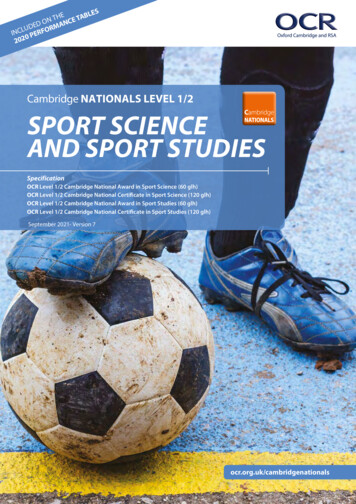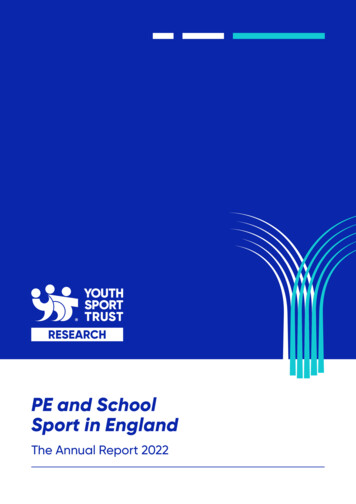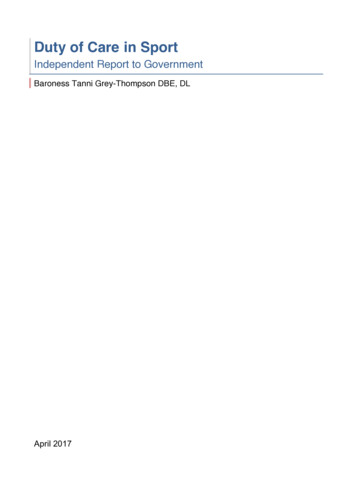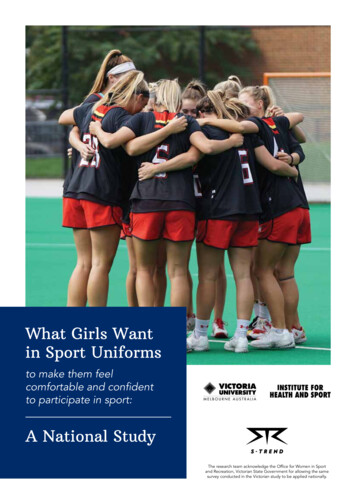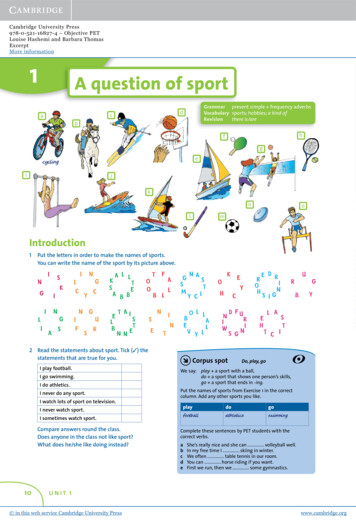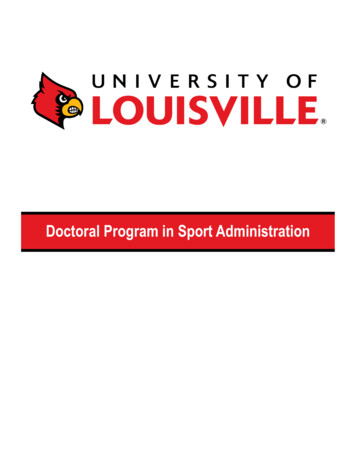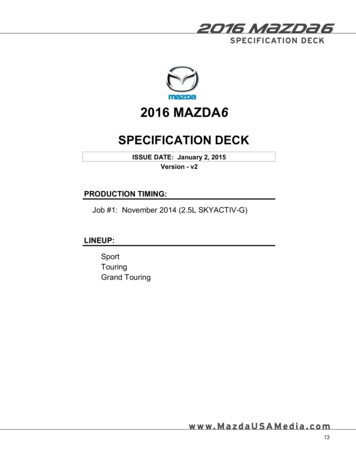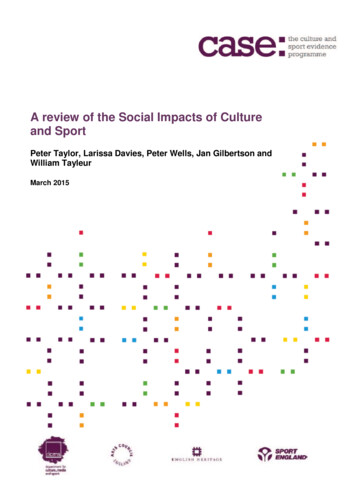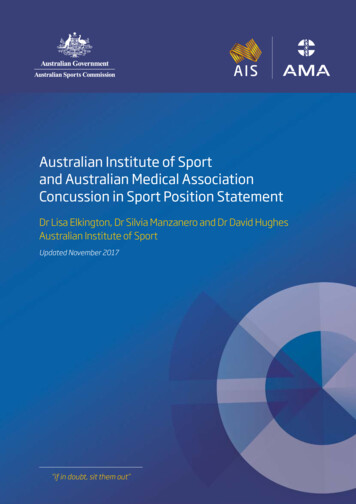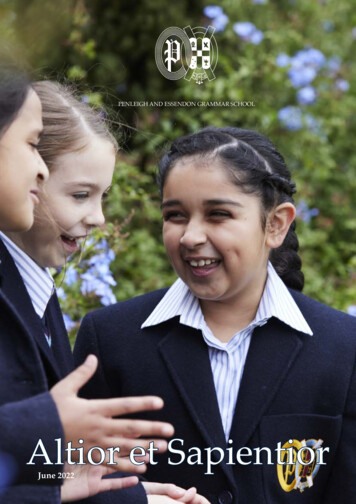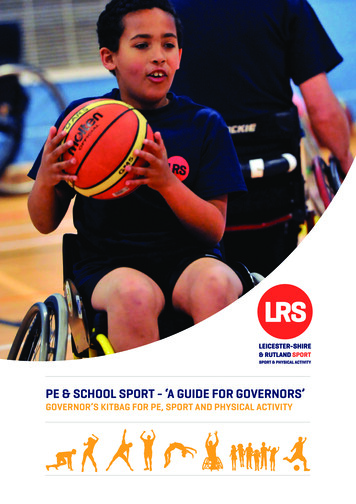
Transcription
PE & SCHOOL SPORT - ‘A GUIDE FOR GOVERNORS’GOVERNOR’S KITBAG FOR PE, SPORT AND PHYSICAL ACTIVITY
PE & School Sport – ‘A Guide for Governors’. ‘Governor’s kitbag for PE, Sport and Physical Activity’About us:Leicester-Shire and Rutland Sport (LRS) is a partnership of Local Authorities ofLeicestershire, Leicester and Rutland working together with schools, National Governing Bodies of Sport (NGBs), clubs, coaches and volunteers to create a lastinglegacy for PE, sport and physical activity. Our focus is to ensure that national sporthas local reach.Our ambition for the children and young people of Leicestershire, Leicester andThis has been created by a team ofThoseRutlandwithis thatlongtherememoriesis a year on year increase in participations of high quality PE,expertsPrimaryand aimsto towillrecallmy confessingtosportand physicalactivity. This documentisenthusiasticdesigned to supportSchoolsprovideyouor your‘SportseffectivelyPE and SportfundingwhileguidingthemGovernor’on the asyouthat utiliseI hadtheirpromisedat Premiumcolleaguewitheverythingyouneedsociated Ofsted inspection requirements.theSports Advocates Dinnerto get thebest headingsvalue forwhichmoneyfromThe information is subdivided into specific EandSportsPremium.accessed as dictated by the needs of each school. However, it is recommended thatGovernorsAssociation)wouldthe mostschools use theflowchart to identifyrelevantCOLGAare sectionsgrateful oftotheIandocument.Knott, gnpost,howeverallkeyexterset up a small task force toMorris and Gaynor Nash for thenal documents will be credited and links provided.‘expertise’ contributions and I ampreparea Governor’s Tool KitFor further information or guidance please contact:grateful to Steve Wilson of the COLGAforSport – nowre-badgedLeicester-shireand RutlandSport (LRS) www.lrsport.orgExecutive for his help in steering thisFOReWoRDThe Sports Governor’s Kitwork to fruition.IanKnottBag!! So please open up thisNowit is -upto you – checktheSports Development Manager (Education andSkills)Leicester-Shire& Rutlandkitbagandmakeuseofthecontents and you’ll find all theSportmaterialinside. 01509 564861‘challenging questions’ you need toi.knott@lboro.ac.ukask in YOUR school to make sure weGeoff Maltbybest opportunities.AskingSports Development Manager (NGBs, SchooldeliverGamesthe& competition)- Leicester-Shirechallenging questions is the main& Rutland Sportfunction of the Sports Governor –g.maltby@lboro.ac.uk 01509 564862every school needs one!Document symbol key:Key points to noteReferenced document/ website URLgosmartfor it.phonesQR code for direct link to document/websiteTake(thisupcanthebe batonread byandmostor tablets).Michael Burdencontents1. Background1.1 The wider benefit of a high quality physical education and school sportprogramme42. Introduction2.1 High quality PE should be a universal entitlement of all pupils63.3.13.23.3The New PE & Sport Premium Investment8What is the PE & sport Premium?Using your primary school sport funding effectivelyOfsted will monitor the impact of this funding on primary PE and school sport andreport on its findings3.4 What impact should this funding have?4.4.14.24.34.4Key Questions for GovernorsAchievement of pupilsQuality of teachingBehaviour and safety of pupilsQuality of leadership and management105. Local Support126. Appendix A – The self-review tool14Chair of Leicester City Governors00:00:200:00:3
PE & School Sport – ‘A Guide for Governors’. ‘Governor’s kitbag for PE, Sport and Physical Activity’1.BACKGROUNDA small working group made up of members of Leicester-Shire & Rutland Sport(LRS), the School Sport & Physical Activity Networks (SSPANs), EducationImprovement Partnership (EIP), City Primary Heads (CPH), Youth Sport Trust andCity Of Leicester Governors Association (COLGA) have developed this guidance toinform, advise and support schools on PE and school sport.“PE, school sport and physical activity is vitally important in creating a roundededucation for our children and young people. As governors it is our responsibilityto ensure that PE is not only given the time on the timetable, but is of a high qualitydelivered by enthused and well-equipped teachers, supported by qualified sportscoaches which meets the requirements of Ofsted”.Steve WilsonChair of South Highfields Community Federation00:00:41.1 The wider benefit of a high quality physical education and school sport programme:High quality physical education and school sport contributes to a range of outcomes for young people.Not only does it equip young people with physical literacy while supporting their physical development,movement skills and body confidence, but it also contributes to their physical, mental and emotional healthand well-being. It is also a powerful vehicle for developing wider skills, qualities and aspirations through theirinvolvement in the subject, as participants, leaders and organisers.It is well evidenced that a positive relationship exists between physical activity and enhanced cognitiveskills including those of memory, attention and concentration. But it is primary age children who, fromparticipating in as little as 10 minutes of additional organised physical activity a day, gain the most benefit interms of enhanced cognitive function, improved classroom behaviour and consequently enhanced academicperformance*. A high quality PE and school sport programme may aid these developments, but in order tomaximise the impact on a child’s attainment and overall achievement, PE and sport needs to be a deliberateand explicit part of a child’s educational journey. Without planned intervention only 10% of children willtransfer gains made through it into measurable school achievement outcomes.Therefore schools need to develop their PE, physical activity and school sport provision to contribute to theiroverall strategy of raising achievement and improving standards, not just as a way of increasing physicalactivity levels and fitness.*Stead R, and Neville M (2010), The Impact of Physical Education and Sport on Education Outcomes: A Review of Literature. Institute of Youth Sport, Loughborough University.00:00:5
PE & School Sport – ‘A Guide for Governors’. ‘Governor’s kitbag for PE, Sport and Physical Activity’2.1 High quality PE should be a universal entitlement of all pupils:The terms ‘Physical Education’, ‘physical activity’ and ‘sport’ are often used interchangeably but it is importantfor governors to understand the difference between them to provide the best possible sporting start in life foryoung people. Physical Education is described as the foundation block. It is the curriculum subject, deliveredby teachers sometimes supported by coaches, that ensures all young people achieve physical literacy.2.INTRODUCTIONDeveloping on from these experiences, schools should also provide extra-curricular opportunities that developlife-long healthy, active lifestyles and competitive sport participation.There are key elements that should be considered when developing experiences within the strands of PhysicalEducation, physical activity and sport, and the model below outlines some of these differences.Physical activities todevelop life-long healthy,active lifestylesEnjoyment, Engagement, ExerciseAs we look forward in 2014 we canlook back with pride to the summerof 2012 and the greatest sportingsummer of our lives. We aimed to‘Inspire a Generation’, and I hope youwill agree that we did that, but forthere to be genuine and sustainablelegacy that inspiration must becomeparticipation. We waited some timefor the Government to find fundingto ensure that our schools can be acornerstone of that Legacy and we nowhave that in the form of 150 millionof Primary Physical Education andSchool Sport funding. Local schools willreceive 8,000 plus 5 per child so thata school with 300 pupils will have anadditional 9,500 in its budget.00:00:6As a school governor myself I know the key rolegoverning bodies play in schools. I know too that wesometimes need help in getting our heads aroundnew initiatives so that we can best support the Headand staff team. This ‘Toolkit’ is intended to supportour understanding of how the money should be usedto develop sustainable physical education in ourprimary schools that will help children develop thephysical literacy that will be as important in their livesas the literacy and numeracy that we all work so hardto support. Without that physical literacy our childrenwill only be able to dream of emulating the stars thatinspired them in 2012.I hope that you will find it useful in helping yourschool develop healthier, better coordinated childrenas well as satisfy Ofsted inspectors that the fundingis being used effectively. Who knows, good use of thefunding could help unearth the new Jessica Ennis,David Weir or even Gary Lineker.Gaynor NashGovernor at Folville Primary School and RegionalCoordinator 2012 Legacy Children & Young People.Physical educationLiteracy, Learning, LeadershipHigh quality physical education isplanned, progressive, inclusive anddelivered as part of the curriculum byprimary teachers.It develops a child’s physical literacyas well as their self-confidence,understanding of teamwork andleadership skills.It is the base on which the foundationfor an active lifestyle as well asperformance in competitive sport isbuilt.Healthy, active lifestyles are developedthrough a focus on enjoyment. Engage pupilsby offering a breadth of appealing activitiesthat include plenty of exercise and promotewider health and well-being messages in ayoung people centred environment.Competitive school sportto develop life-long sportparticipationCoaching, Competition, ClubsCompetitive school sport for primary childrenshould focus on achieving one’s ‘personalbest’ rather than being ‘the best’.A good programme includes regular clubparticipation opportunities where childrenlearn more about specific sports, engagein age-appropriate coaching and practisetheir skills.00:00:7
PE & School Sport – ‘A Guide for Governors’. ‘Governor’s kitbag for PE, Sport and Physical Activity’3.The new PE & Sport Premium Investment3.1 What is the PE & Sport Premium?The new primary PE and sport funding is additionalfunding of 150 million per year for the next threeacademic years, 2013-2014, 2014-2015 and 20152016. It has been provided jointly by the Departmentsfor Education, Health and Culture, Media and Sportand will go directly to primary schools to spend onimproving the quality of Physical Education, sport andphysical activity for all their pupils.3.2 Using your primary school sport fundingeffectively:Schools must spend the additional funding onimproving their provision of PE, sport and physicalactivity. Schools will have the freedom to choosehow they do this but the funding is ring-fenced andtherefore can only be spent on PE, sport and physicalactivity. It is also important that it is used to developteacher confidence and competence in the deliveryof PE as it is widely recognised that primary teacherslack training and support to deliver high qualityPE. Decisions on how the funding is used must bemade by school leaders; however local advice andguidance can be sought from your School Sport& Physical Activity Networks (SSPANs). If you areunsure of who your local contact is contact detailsare provided in section 5. By working collaboratively,or in clusters, primary schools may be able to developa sustainable, long term local structures that willresult in good value quality provision, responsive tolocal contexts.3.3 Ofsted will monitor the impact of this fundingon primary PE and school sport and report on itsfindings:Primary schools will be required to include detailson their website about how they are using the newfunding on improving PE, sport and physical activity.Inspectors will review this information prior to aSection 5 inspection and as a governor you may wellbe asked about the schools use of this resource.3.4 What impact should this funding have?Ofsted will be looking for the impact this fundingmakes on the quality of PE and school sport both inrelation to pupil experiences and primary school staffexpertise in delivering the subject. From September2013, Ofsted will strengthen its coverage of PE andsport and inspectors will be observing primary PElessons. From January 2014 Ofsted will also bemaking a ‘yes’, ‘no’ judgement about whether schoolsare using their funding effectively.Inspectors have been asked to consider the impactof the new primary school sport funding on pupils’lifestyles and physical wellbeing by taking account ofthe following factors: 2 The increase in participation rates in such activitiesas games, dance, gymnastics, swimming andathletics The increase and success in competitive schoolsports How much more inclusive the Physical Educationcurriculum has become The growth in the range of provisional andalternative sporting activities The improvement in partnership work on PhysicalEducation with other schools and other localpartners Links with other subjects that contribute to pupils’overall achievement and their greater social,spiritual, moral and cultural skills The greater awareness amongst pupils aboutthe dangers of obesity, smoking and other suchactivities that undermine pupils’ health.Judgements will be made by inspectors about thequality of teaching and its impact on pupils’ learningand progress, and on their behaviour.In meetings with school leaders and governors,inspectors will ask for a brief evaluation of the qualityof PE, pupils’ participation in school sport and howschools have used the new primary school funding tomake improvements. Inspectors will also ask pupilstheir views about PE, about their participation inlunchtime and after-school sport and what else theschool does to keep them healthy and active.Primary schools should expect that Ofsted will belooking at the way they are tackling the commonweaknesses as identified in the most recentinspection survey report of the overall effectivenessof PE, Beyond 2012 –Outstanding Physical Educationfor all (2013) g-physical-educationfor-all. Whilst this report found that PE was good oroutstanding in two thirds of the 120 primary schoolsvisited, it identified a number of common weaknessesin primary PE including: teachers’ lack of detailed subject knowledge superficial lesson planning and limited use ofassessment not enough opportunities for pupils to participateand compete in school sport insufficient focus on promoting pupils’ physicalfitness no strategy to improve the health and well-being ofall pupils not all pupils could swim 25 metres unaided by theend of Key Stage 2.The introduction of this new funding provides primaryschools with an ideal opportunity to tackle thesecommon weaknesses in PE and sport. It should beused to add value to the quality of PE and schoolsport, not simply maintain current provision andenable schools to make a real difference.00:00:800:00:92 Subsidiary Guidance, supporting the inspection of maintained schools and academies (September 2013)
PE & School Sport – ‘A Guide for Governors’. ‘Governor’s kitbag for PE, Sport and Physical Activity’4.Key Questions for Governors“The Ofsted message for PE was that inspectors wanted to see schools putting actions inplace to improve the health and levels of physical activity of all pupils through quality PElessons and a range of inclusive additional activities outside the curriculum. Inspectorswanted to see pupils active throughout most of a lesson or session and making progressin skills learning, making good value for money use of the School Sports Premium andthe inspiration of successes in events such as the Olympic Games, Wimbledon etc.”Jane GadsbyHeadteacher, Stokes Wood Primary SchoolTo maximise the impact of the primary Physical Education and sport funding andensure compliance with Ofsted accountability measures, governing bodies willbe supporting and challenging Head teachers and senior leadership teams aboutthe school’s vision, provision and impact of PE, sport and physical activity. Thefollowing questions, arranged under Ofsted judgment headings, may be usefulstarting points for these discussions:4.1 Achievement of pupils:1. How does Physical Education and school sportcontribute to the overall attitude, behaviour andachievement of all our pupils?All pupils are engaged, motivated, demonstrate ahigh level of understanding and skill and take somelead in high quality PE lessons. Behaviour is excellentacross all PE lessons and has improved in all lessonsand at break and lunchtime. Pupils make decisionsthat challenge and inspire them even further and areachieving high levels of progress in all subjects.2. Is the progress and achievement of all pupils inPhysical Education consistently good or outstanding?All pupils make good or outstanding progress whichis clearly reported to parents or carers. Assessmentinvolves pupils fully and identifies and celebratestheir achievements.3. Is a varied programme of extra-curricular sportand physical activity offered to pupils and are theyengaged in deciding what activities are provided?All pupils are able to access a broad offer ofschool sport activities (as participants, leadersor organisers). An extensive range of sports isavailable, including opportunities for young disabledpeople, through a programme that both respondsto demand and introduces sports activities that thepupils may not otherwise experience. Utilising the‘Me and My’ Pupil Insight Software is an excellentway of determining pupil needs around PE, sport andphysical activity.00:00:104. Do all pupils participate in this programme ofextra-curricular sport and physical activity?Most young people participate in activities eitherbefore or after school. They enjoy competing againsteach other and are developing values that areestablishing regular participation habits.5. Do we participate in high quality competitiveopportunities with other schools and are wesuccessful?Most young people represent the school and arepart of community clubs that the school has linkswith. Pupils’ take part in Level 2 School GamesCompetitions.4.2 Quality of teaching:6. How much time do we devote to the teaching ofPhysical Education?All pupils receive two hours or more of timetabledhigh quality PE.7. How does our school ensure that the PhysicalEducation curriculum is engaging and stretching forall pupils?The PE curriculum is diverse, providing pupils withthe confidence to try new activities as well asenhancing their existing skills in a diverse range ofenvironments. There are opportunities for allpupils to develop their leadership, coaching andofficiating skills.8. Is the teaching and learning of Physical Educationin our school consistently good or outstanding?12. Who takes a lead for Physical Education in ourschool?All staff are confident and competent to deliverhigh quality PE and the quality of all lessons isgood or outstanding. Staff provide for the leastand most-able pupils and recognise, pupils learn indifferent ways.The PE co-ordinator is an experienced highly skilledclassroom teacher. They are able to cascade trainingand motivate staff. They have the support of theHead teacher, staff, governors, pupils and parents.4.3 Behaviour and safety of pupils:9. How does our school ensure the extra-curricularprogramme is of a high quality and delivered safely?Teachers are supported in the delivery of the extracurricular programme by quality assured coacheswho extend, enrich and enhance the experience forthose young people who are interested or talented insport. National governing body (NGB) coaches havebeen used to up-skill teachers’ technical knowledgein a particular activity when the need was identified.10. How does our school ensure that physicalactivity contributes to the health and well-being ofall our pupils?The school has a clear physical activity policy whichincorporates PE and school sport but also offersinformal physical activity such as break-time activity,active travel and supervised play. Staff can identifytarget groups of pupils that are deemed lessactive and barriers to their participation are beingaddressed. Positive attitudes towards healthy andactive lifestyles are encouraged amongst pupils andstaff, and extended to parents and carers.4.4 Quality of leadership and management:11. Does our school have a clear vision for highquality Physical Education and school sport thatcontributes to the whole school development plan?There is a clear vision statement included in theschool’s aims that recognises the value and impactof high quality PE and school sport which pupils andparents understand and have contributed to. PE andsport is a central part of the school developmentplan. The context of sport is used across thecurriculum and the skills and positive values of sportare integrated into the school ethos. PE and sportare used to engage the wider community and fosterpositive relationships with other schools.13. Do we have a strategy for ensuring effectiveprofessional development in Physical Education?There are termly opportunities for staff to participatein CPD relevant to high quality PE. The PE coordinator has release time to build capacity with staffincluding jointly planning lessons, team teaching andbeing observed teaching.14. D o we work in partnership with other schoolsand local partners to maximise our provision?The school is part of a cluster partnership for PEand school sport managed by the School Sport &Physical Activity Networks (SSPANs). This partnershiporganises an extensive range of competitive sportingopportunities for pupils. The school also has excellentlinks with Leicester-Shire & Rutland Sport (LRS).15. D oes our school have a clear plan for the use ofthe Primary Physical Education and sport funding?It is clear how the planned budget will improveprovision and outcomes in PE, physical activity andschool sport.16. Who is responsible for monitoring andevaluating the impact of this funding in our school?Budgets are monitored regularly by the leadershipteam, enabling the school to see which elementsof spend have the greatest and most sustainableimpact.17. How will the impact of this funding be reportedto the governing body?The impact of this funding will be reported to thegoverning body each term and presentations made intwo identified meetings a year.00:00:11
PE & School Sport – ‘A Guide for Governors’. ‘Governor’s kitbag for PE, Sport and Physical Activity’5.LOCAL SUPPORTCharnwood (North). Charnwood College, Thorpe Hill, Loughborough, LE11 4SQJess RobinsonSchool Sport Development ManagerJessica.Robinson@CharnwoodCollege.org01509 554460Charnwood (South). Longslade Community College, Wanlip Lane, Birstall, LE4 4GHSally WickenSchool Sport Development Managerwallersally@hotmail.com0116 267 0808Aaron AsawlaSchool Sport Development ManagerAaronasawla@longslade.leics.sch.uk0116 267 7107Hinckley & Bosworth. Bosworth Academy, Leicester Lane, Desford, LE9 9JLChris RipleySchool Sport & Physical Activity Network Managerchrisr9@bosworthacademy.org.uk01455 822841 ext.249Leicester City (West Leicester). The Lancaster School, Knighton Lane East, Leicester, LE2 6FUNicky CollettSchool Sport Development Managerncollett@lancaster.leicester.sch.uk0116 274 5283Leicester City (East Leicester). Crown Hills Community College, Gwendolen Road, Leicester, LE5 5FTSarah LansdowneSchool Sport Development Manager (Mon-Wed)sarahgoacher@yahoo.co.uk0116 249 1016Dan HewinsSchool Sport Development Manager (Wed-Fri)danhewins.ch@gmail.com0116 249 1016Special Schools Network. Ellesmere College, Ellesmere Road, Leicester, LE3 1BESandra PughDisability School Sport Development Managerpugh.sandra@googlemail.com0116 289 4224John DugganDisability School Sport Development Managerjohnduggan48@hotmail.co.uk0116 289 4224Melton. Longfield High School, Ambleside Way, Melton Mowbray, LE13 0BIneke WardSchool Sport Development Manager (Tues/Wed/Thurs)iward@longfield.leics.sch.uk01664 561234 ext 167North West Leicestershire. King Edward VII Science & Sport College, Warren Hills Rd, Coalville, LE67 4UWRachel HarrisonDirector of Sport and Community Developmentrharrison@kinged.org.uk01530 838217Steve BensonSchool Sports Operations Managersbenson@kinged.org.uk01530 516366Rutland. Rutland County Council, Council Offices, Catmose, Oakham, LE15 6HPChris ThomasSchool Sport Development ManagerCThomas@rutland.gov.uk01572 758378Learning South Leicestershire (Blaby & Harborough).South Wigston High School, St. Thomas Road, South Wigston, LE18 4TARuth MannSchool Sport Development Manager (Wed-Fri)rmann@countesthorpe.leics.sch.uk0116 277 4575Anne ClarkeSchool Sport Development Manageranneclarke1801@gmail.com0116 277 457500:00:1200:00:13
PE & School Sport – ‘A Guide for Governors’. ‘Governor’s kitbag for PE, Sport and Physical Activity’6.(Appendix A – The self-review tool)PE and School Sport: How to become Outstanding.This self-review tool will help schools to assess their provision and outcomes in PE and school sport. It willalso help to identify your school’s priorities for development. Simply look for the best fit against each of thenine questions and list the evidence available to support your judgement against the three levels ofdevelopment: Emerging, Established or Embedded.QuestionsEmergingEstablishedEmbedded1. Does your school havea vision for PE and schoolsport?There is a limited (or no) vision which identifies the potential fora whole school approach to, or recognises the value of, PE andschool sport.There is a vision statement, adopted across the school andincluded in public documents available to parents/carers.There is a clear vision statement included in the school’s aimsthat recognises the value and impact of high quality PE and schoolsport which parents and pupils understand and have contributedto.2. Does your PE and schoolsport provision contribute tooverall school improvement?PE and school sport are recognised for the impact they have ona positive school ethos and there is some attempt to use majorsporting events or the positive values of sport in whole-schoolstrategies.PE and school sport are celebrated across the life of the school.The context of sport is regularly used in other curriculum areasand as a whole-school theme.PE and school sport is a central part of the school developmentplan. The context of sport is used across the curriculum andthe skills and positive values of sport are integrated into theschool ethos. PE and school sport are used to engage the widercommunity and foster positive relationships with other schools.3. Do you have strongleadership and managementof PE and school sport?The Headteacher understands the importance of PE and schoolsport and there is an identified PE CoordinatorThe PE Co-ordinator is a skilled professional who has developedcore provision and is supporting all staff. The Headteacher valuesPE and school sport and it is integral to school developmentThere is a detailed PE development plan with short and long-termtargets that enable all pupils (including key groups) to progressand achieve. The PE Co-ordinator is highly skilled, able to motivatestaff and has the support of the Headteacher, staff, governors,pupils and parents. Staff regularly participate in CPD relevant tohigh quality PE4. Do you provide a broad,rich and engaging PEcurriculum?The PE curriculum covers the minimum National Curriculumexpectations in a safe, yet limited, range of environments. Itfocuses mainly on developing pupils’ physical skills. Pupils receiveless than two hours timetabled PE each week.The PE curriculum is broad and balanced, going beyond theNational Curriculum expectations. It is fun and delivered safelyin a range of environments, which develops all physical skills andsome leadership and coaching skills of pupils. All pupils receivetwo hours of timetabled PE.The PE curriculum is diverse, providing pupils with the confidenceto achieve sporting excellence and opportunities to try newactivities as well as enhancing their existing skills in a diverserange of environments. There are opportunities for all pupils todevelop their leadership, coaching and officiating skills. All pupilsreceive two hours or more of timetabled, high quality PE.5. How good is the teachingand learning of PE in yourschool?The confidence and competence of staff varies. A limited numberof lessons are good or outstanding. Most pupils make someprogress but assessment lacks rigour. Limited reporting ofprogress to parents or carers.Most staff are confident and competent to use a range of teachingand learning styles in PE. Most lessons are good or outstanding.The majority of pupils make good progress, which is fully reportedto parents or carers, and there is a sound assessment process.All staff are confident and competent to deliver high quality PEand the quality of all lessons is consistently good or outstanding.Teaching and learning styles are matched to lesson content and toencouraging all pupils to participate. All pupils make consistentlygood progress which is clearly and regularly reported to parentsand carers. Assessment involves pupils fully and identifies andcelebrates their achievements.6. Are you providing highquality outcomes for youngpeople through PE andschool sport?Most pupils are engaged in PE and can demonstrate their levelof understanding and skill. The majority of behaviour is good andpupils are starting to make healthy lifestyle choices.All pupils are engaged in PE and can demonstrate their level ofunderstanding and skill. Behaviour is good across all PE lessonsand pupils co-operate in collaborative and competitive situations.All pupils are starting to make healthy lifestyle choices.All pupils are engaged, motivated, demonstrate a high level ofunderstanding and skill and take some lead in high quality PElessons. Behaviour is excellent across all PE lessons and hasimproved in all lessons and at break and
"PE, school sport and physical activity is vitally important in creating a rounded education for our children and young people. As governors it is our responsibility . A Review of Literature. Institute of Youth Sport, Loughborough University. 00:00:7 PE & School Sport - 'A Guide for Governors'. 'Governor's kitbag for PE, Sport and .
